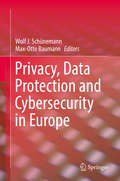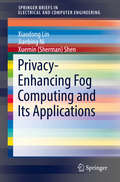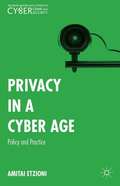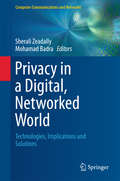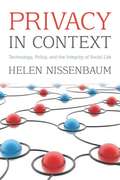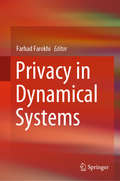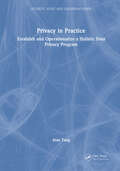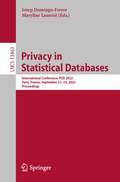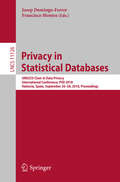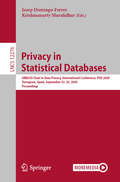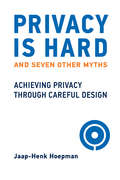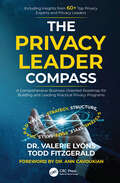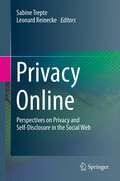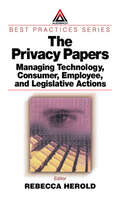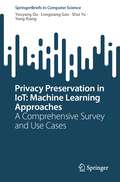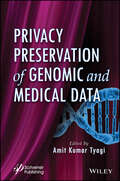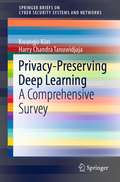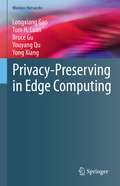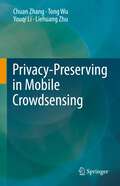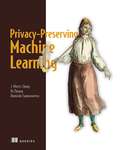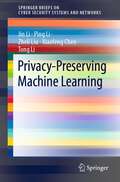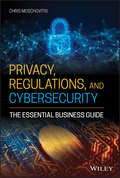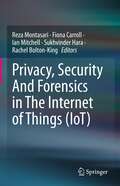- Table View
- List View
Privacy, Data Protection and Cybersecurity in Europe
by Wolf J. Schünemann Max-Otto BaumannThis book offers a comparative perspective on data protection and cybersecurity in Europe. In light of the digital revolution and the implementation of social media applications and big data innovations, it analyzes threat perceptions regarding privacy and cyber security, and examines socio-political differences in the fundamental conceptions and narratives of privacy, and in data protection regimes, across various European countries. The first part of the book raises fundamental legal and ethical questions concerning data protection; the second analyses discourses on cybersecurity and data protection in various European countries; and the third part discusses EU regulations and norms intended to create harmonized data protection regimes.
Privacy, Due Process and the Computational Turn: The Philosophy of Law Meets the Philosophy of Technology
by Mireille Hildebrandt Katja De VriesPrivacy, Due process and the Computational Turn: The Philosophy of Law Meets the Philosophy of Technology engages with the rapidly developing computational aspects of our world including data mining, behavioural advertising, iGovernment, profiling for intelligence, customer relationship management, smart search engines, personalized news feeds, and so on in order to consider their implications for the assumptions on which our legal framework has been built. The contributions to this volume focus on the issue of privacy, which is often equated with data privacy and data security, location privacy, anonymity, pseudonymity, unobservability, and unlinkability. Here, however, the extent to which predictive and other types of data analytics operate in ways that may or may not violate privacy is rigorously taken up, both technologically and legally, in order to open up new possibilities for considering, and contesting, how we are increasingly being correlated and categorizedin relationship with due process – the right to contest how the profiling systems are categorizing and deciding about us.
The Privacy Engineer's Manifesto: Getting from Policy to Code to QA to Value
by Michelle Finneran Dennedy Jonathan Fox Thomas R. Finneran"It''s our thesis that privacy will be an integral part of the next wave in the technology revolution and that innovators who are emphasizing privacy as an integral part of the product life cycle are on the right track. " --The authors of The Privacy Engineer''s Manifesto The Privacy Engineer''s Manifesto: Getting from Policy to Code to QA to Value is the first book of its kind, offering industry-proven solutions that go beyond mere theory and adding lucid perspectives on the challenges and opportunities raised with the emerging "personal" information economy. The authors, a uniquely skilled team of longtime industry experts, detail how you can build privacy into products, processes, applications, and systems. The book offers insight on translating the guiding light of OECD Privacy Guidelines, the Fair Information Practice Principles (FIPPs), Generally Accepted Privacy Principles (GAPP) and Privacy by Design (PbD) into concrete concepts that organizations, software/hardware engineers, and system administrators/owners can understand and apply throughout the product or process life cycle--regardless of development methodology--from inception to retirement, including data deletion and destruction. In addition to providing practical methods to applying privacy engineering methodologies, the authors detail how to prepare and organize an enterprise or organization to support and manage products, process, systems, and applications that require personal information. The authors also address how to think about and assign value to the personal information assets being protected. Finally, the team of experts offers thoughts about the information revolution that has only just begun, and how we can live in a world of sensors and trillions of data points without losing our ethics or value(s). . . and even have a little fun. The Privacy Engineer''s Manifesto is designed to serve multiple stakeholders: Anyone who is involved in designing, developing, deploying and reviewing products, processes, applications, and systems that process personal information, including software/hardware engineers, technical program and product managers, support and sales engineers, system integrators, IT professionals, lawyers, and information privacy and security professionals. This book is a must-read for all practitioners in the personal information economy. Privacy will be an integral part of the next wave in the technology revolution; innovators who emphasize privacy as an integral part of the product life cycle are on the right track. Foreword by Dr. Eric Bonabeau, PhD, Chairman, Icosystem, Inc. & Dean of Computational Sciences, Minerva Schools at KGI. What you''ll learn What''s at stake as concerns data privacy become critical considerations for users, developers, and enterprise stakeholders Comprehensive foundational understanding of the issues and how they are interconnected What the emerging job description of "privacy engineer" means Key development models for privacy architecture How to assemble an engineering privacy tool box (including developing privacy use cases and requirements Organizational design implications of privacy engineering Quality Assurance (QA) methodologies for privacy policy compliance Models for valuing data The 10-point Manifesto of the Privacy Engineer Who this book is for The Privacy Engineer''s Manifesto is designed to serve multiple stakeholders: Anyone who is involved in designing, developing, deploying, and reviewing products, processes, applications, and systems that process personal information, including software/hardware engineers, technical program and product managers, support and sales engineers, system integrators, IT professionals, lawyers, and information privacy and security professionals. A must read for all practitioners in the personal information economy. Table of Contents Part 1 - Getting Your Head Around Privacy Chapter 1: Technology Evolution and People Chapter 2: Foundational Concepts and Frameworks Chapter 3: Data and Privacy Governance Concepts Part 2 - The Privacy Engineering Pr...
Privacy-Enhancing Fog Computing and Its Applications (SpringerBriefs in Electrical and Computer Engineering)
by Xiaodong Lin Jianbing Ni Xuemin Sherman ShenThis SpringerBrief covers the security and privacy challenges in fog computing, and proposes a new secure and privacy-preserving mechanisms to resolve these challenges for securing fog-assisted IoT applications. Chapter 1 introduces the architecture of fog-assisted IoT applications and the security and privacy challenges in fog computing. Chapter 2 reviews several promising privacy-enhancing techniques and illustrates examples on how to leverage these techniques to enhance the privacy of users in fog computing. Specifically, the authors divide the existing privacy-enhancing techniques into three categories: identity-hidden techniques, location privacy protection and data privacy enhancing techniques. The research is of great importance since security and privacy problems faced by fog computing impede the healthy development of its enabled IoT applications. With the advanced privacy-enhancing techniques, the authors propose three secure and privacy-preserving protocols for fog computing applications, including smart parking navigation, mobile crowdsensing and smart grid. Chapter 3 introduces identity privacy leakage in smart parking navigation systems, and proposes a privacy-preserving smart parking navigation system to prevent identity privacy exposure and support efficient parking guidance retrieval through road-side units (fogs) with high retrieving probability and security guarantees. Chapter 4 presents the location privacy leakage, during task allocation in mobile crowdsensing, and propose a strong privacy-preserving task allocation scheme that enables location-based task allocation and reputation-based report selection without exposing knowledge about the location and reputation for participators in mobile crowdsensing. Chapter 5 introduces the data privacy leakage in smart grid, and proposes an efficient and privacy-preserving smart metering protocol to allow collectors (fogs) to achieve real-time measurement collection with privacy-enhanced data aggregation. Finally, conclusions and future research directions are given in Chapter 6. This brief validates the significant feature extension and efficiency improvement of IoT devices without sacrificing the security and privacy of users against dishonest fog nodes. It also provides valuable insights on the security and privacy protection for fog-enabled IoT applications. Researchers and professionals who carry out research on security and privacy in wireless communication will want to purchase this SpringerBrief. Also, advanced level students, whose main research area is mobile network security will also be interested in this SpringerBrief.
Privacy in a Cyber Age
by Amitai EtzioniThis book lays out the foundation of a privacy doctrine suitable to the cyber age. It limits the volume, sensitivity, and secondary analysis that can be carried out. In studying these matters, the book examines the privacy issues raised by the NSA, publication of state secrets, and DNA usage.
Privacy in a Digital, Networked World
by Sherali Zeadally Mohamad BadraThis comprehensive textbook/reference presents a focused review of the state of the art in privacy research, encompassing a range of diverse topics. The first book of its kind designed specifically to cater to courses on privacy, this authoritative volume provides technical, legal, and ethical perspectives on privacy issues from a global selection of renowned experts. Features: examines privacy issues relating to databases, P2P networks, big data technologies, social networks, and digital information networks; describes the challenges of addressing privacy concerns in various areas; reviews topics of privacy in electronic health systems, smart grid technology, vehicular ad-hoc networks, mobile devices, location-based systems, and crowdsourcing platforms; investigates approaches for protecting privacy in cloud applications; discusses the regulation of personal information disclosure and the privacy of individuals; presents the tools and the evidence to better understand consumers' privacy behaviors.
Privacy in Context
by Helen NissenbaumPrivacy is one of the most urgent issues associated with information technology and digital media. This book claims that what people really care about when they complain and protest that privacy has been violated is not the act of sharing information itself-most people understand that this is crucial to social life -but the inappropriate, improper sharing of information. Arguing that privacy concerns should not be limited solely to concern about control over personal information, Helen Nissenbaum counters that information ought to be distributed and protected according to norms governing distinct social contexts-whether it be workplace, health care, schools, or among family and friends. She warns that basic distinctions between public and private, informing many current privacy policies, in fact obscure more than they clarify. In truth, contemporary information systems should alarm us only when they function without regard for social norms and values, and thereby weaken the fabric of social life.
Privacy in Dynamical Systems
by Farhad FarokhiThis book addresses privacy in dynamical systems, with applications to smart metering, traffic estimation, and building management. In the first part, the book explores statistical methods for privacy preservation from the areas of differential privacy and information-theoretic privacy (e.g., using privacy metrics motivated by mutual information, relative entropy, and Fisher information) with provable guarantees. In the second part, it investigates the use of homomorphic encryption for the implementation of control laws over encrypted numbers to support the development of fully secure remote estimation and control. Chiefly intended for graduate students and researchers, the book provides an essential overview of the latest developments in privacy-aware design for dynamical systems.
Privacy in Practice: Establish and Operationalize a Holistic Data Privacy Program (ISSN)
by Alan TangPrivacy is not just the right to be left alone, but also the right to autonomy, control, and access to your personal data. The employment of new technologies over the last three decades drives personal data to play an increasingly important role in our economies, societies, and everyday lives. Personal information has become an increasingly valuable commodity in the digital age.At the same time, the abundance and persistence of personal data have elevated the risks to individuals’ privacy. In the age of Big Data, the Internet of Things, Biometrics, and Artificial Intelligence, it is becoming increasingly difficult for individuals to fully comprehend, let alone control, how and for what purposes organizations collect, use, and disclose their personal information. Consumers are growing increasingly concerned about their privacy, making the need for strong privacy champions ever more acute.With a veritable explosion of data breaches highlighted almost daily across the globe, and the introduction of heavy-handed privacy laws and regulatory frameworks, privacy has taken center stage for businesses. Businesses today are faced with increasing demands for privacy protections, ever-more complex regulations, and ongoing cybersecurity challenges that place heavy demands on scarce resources. Senior management and executives now acknowledge privacy as some of the biggest risks to the business.Privacy, traditionally, has existed in a separate realm, resulting in an unintentional and problematic barrier drawn between the privacy team and the rest of the organization. With many regulatory frameworks to consider, building an all-encompassing data privacy program becomes increasingly challenging. Effective privacy protection is essential to maintaining consumer trust and enabling a robust and innovative digital economy in which individuals feel they may participate with confidence.This book aims at helping organizations in establishing a unified, integrated, enterprise-wide privacy program. This book is aiming to help privacy leaders and professionals to bridge the privacy program and business strategies, transform legal terms and dead text to live and easy-to-understand essential requirements which organizations can easily implement, identify and prioritize privacy program gap initiatives and promote awareness and embed privacy into the everyday work of the agency and its staff.
Privacy in Statistical Databases: International Conference, PSD 2022, Paris, France, September 21–23, 2022, Proceedings (Lecture Notes in Computer Science #13463)
by Josep Domingo-Ferrer Maryline LaurentThis book constitutes the refereed proceedings of the International Conference on Privacy in Statistical Databases, PSD 2022, held in Paris, France, during September 21-23, 2022.The 25 papers presented in this volume were carefully reviewed and selected from 45 submissions. They were organized in topical sections as follows: Privacy models; tabular data; disclosure risk assessment and record linkage; privacy-preserving protocols; unstructured and mobility data; synthetic data; machine learning and privacy; and case studies.
Privacy in Statistical Databases: UNESCO Chair in Data Privacy, International Conference, PSD 2018, Valencia, Spain, September 26–28, 2018, Proceedings (Lecture Notes in Computer Science #11126)
by Josep Domingo-Ferrer Francisco MontesThis book constitutes the refereed proceedings of the International Conference on Privacy in Statistical Databases, PSD 2018, held in Valencia, Spain, in September 2018 under the sponsorship of the UNESCO Chair in Data Privacy. The 23 revised full papers presented were carefully reviewed and selected from 42 submissions. The papers are organized into the following topics: tabular data protection; synthetic data; microdata and big data masking; record linkage; and spatial and mobility data.Chapter "SwapMob: Swapping Trajectories for Mobility Anonymization" is available open access under a Creative Commons Attribution 4.0 International License via link.springer.com.
Privacy in Statistical Databases: UNESCO Chair in Data Privacy, International Conference, PSD 2020, Tarragona, Spain, September 23–25, 2020, Proceedings (Lecture Notes in Computer Science #12276)
by Josep Domingo-Ferrer Krishnamurty MuralidharThis book constitutes the refereed proceedings of the International Conference on Privacy in Statistical Databases, PSD 2020, held in Tarragona, Spain, in September 2020 under the sponsorship of the UNESCO Chair in Data Privacy.The 25 revised full papers presented were carefully reviewed and selected from 49 submissions. The papers are organized into the following topics: privacy models; microdata protection; protection of statistical tables; protection of interactive and mobility databases; record linkage and alternative methods; synthetic data; data quality; and case studies.The Chapter “Explaining recurrent machine learning models: integral privacy revisited” is available open access under a Creative Commons Attribution 4.0 International License via link.springer.com.
Privacy Is Hard and Seven Other Myths: Achieving Privacy through Careful Design
by Jaap-Henk HoepmanAn expert on computer privacy and security shows how we can build privacy into the design of systems from the start.We are tethered to our devices all day, every day, leaving data trails of our searches, posts, clicks, and communications. Meanwhile, governments and businesses collect our data and use it to monitor us without our knowledge. So we have resigned ourselves to the belief that privacy is hard--choosing to believe that websites do not share our information, for example, and declaring that we have nothing to hide anyway. In this informative and illuminating book, a computer privacy and security expert argues that privacy is not that hard if we build it into the design of systems from the start. Along the way, Jaap-Henk Hoepman debunks eight persistent myths surrounding computer privacy. The website that claims it doesn't collect personal data, for example; Hoepman explains that most data is personal, capturing location, preferences, and other information. You don't have anything to hide? There's nothing wrong with wanting to keep personal information--even if it's not incriminating or embarrassing--private. Hoepman shows that just as technology can be used to invade our privacy, it can be used to protect it, when we apply privacy by design. Hoepman suggests technical fixes, discussing pseudonyms, leaky design, encryption, metadata, and the benefits of keeping your data local (on your own device only), and outlines privacy design strategies that system designers can apply now.
The Privacy Leader Compass: A Comprehensive Business-Oriented Roadmap for Building and Leading Practical Privacy Programs
by Valerie Lyons Todd FitzgeraldCongratulations! Perhaps you have been appointed as the Chief Privacy Officer (CPO) or the Data Protection Officer (DPO) for your company. Or maybe you are an experienced CPO/DPO, and you wonder – "what can I learn from other successful privacy experts to be even more effective?" Or perhaps you are considering a move from a different career path and deciding if this is the right direction for you. Seasoned award-winning Privacy and Cybersecurity leaders Dr. Valerie Lyons (Dublin, Ireland) and Todd Fitzgerald (Chicago, IL USA) have teamed up with over 60 award-winning CPOs, DPOs, highly respected privacy/data protection leaders, data protection authorities, and privacy standard setters who have fought the tough battle. Just as the #1 best-selling and CANON Cybersecurity Hall of Fame winning CISO Compass: Navigating Cybersecurity Leadership Challenges with Insights from Pioneers book provided actionable advice to Chief Information Security Officers, The Privacy Leader Compass is about straight talk – delivering a comprehensive privacy roadmap applied to, and organized by, a time-tested organizational effectiveness model (the McKinsey 7-S Framework) with practical, insightful stories and lessons learned. You own your continued success as a privacy leader. If you want a roadmap to build, lead, and sustain a program respected and supported by your board, management, organization, and peers, this book is for you.
Privacy Online
by Sabine Trepte Leonard ReineckeCommunications and personal information that are posted online are usually accessible to a vast number of people. Yet when personal data exist online, they may be searched, reproduced and mined by advertisers, merchants, service providers or even stalkers. Many users know what may happen to their information, while at the same time they act as though their data are private or intimate. They expect their privacy will not be infringed while they willingly share personal information with the world via social network sites, blogs, and in online communities. The chapters collected by Trepte and Reinecke address questions arising from this disparity that has often been referred to as the privacy paradox. Works by renowned researchers from various disciplines including psychology, communication, sociology, and information science, offer new theoretical models on the functioning of online intimacy and public accessibility, and propose novel ideas on the how and why of online privacy. The contributing authors offer intriguing solutions for some of the most pressing issues and problems in the field of online privacy. They investigate how users abandon privacy to enhance social capital and to generate different kinds of benefits. They argue that trust and authenticity characterize the uses of social network sites. They explore how privacy needs affect users' virtual identities. Ethical issues of privacy online are discussed as well as its gratifications and users' concerns. The contributors of this volume focus on the privacy needs and behaviors of a variety of different groups of social media users such as young adults, older users, and genders. They also examine privacy in the context of particular online services such as social network sites, mobile internet access, online journalism, blogs, and micro-blogs. In sum, this book offers researchers and students working on issues related to internet communication not only a thorough and up-to-date treatment of online privacy and the social web. It also presents a glimpse of the future by exploring emergent issues concerning new technological applications and by suggesting theory-based research agendas that can guide inquiry beyond the current forms of social technologies.
The Privacy Papers: Managing Technology, Consumer, Employee and Legislative Actions (ISSN)
by Rebecca HeroldToday, more than ever, organizations have to cope with increased concerns regarding privacy issues. These concerns are not limited to consumer fears about how information collected by Web sites will be used or misused. They also involve broader issues, including data collected for direct response marketing, privacy of financial and health records,
Privacy Preservation in IoT: A Comprehensive Survey and Use Cases (SpringerBriefs in Computer Science)
by Youyang Qu Longxiang Gao Shui Yu Yong XiangThis book aims to sort out the clear logic of the development of machine learning-driven privacy preservation in IoTs, including the advantages and disadvantages, as well as the future directions in this under-explored domain. In big data era, an increasingly massive volume of data is generated and transmitted in Internet of Things (IoTs), which poses great threats to privacy protection. Motivated by this, an emerging research topic, machine learning-driven privacy preservation, is fast booming to address various and diverse demands of IoTs. However, there is no existing literature discussion on this topic in a systematically manner. The issues of existing privacy protection methods (differential privacy, clustering, anonymity, etc.) for IoTs, such as low data utility, high communication overload, and unbalanced trade-off, are identified to the necessity of machine learning-driven privacy preservation. Besides, the leading and emerging attacks pose further threats to privacy protection in this scenario. To mitigate the negative impact, machine learning-driven privacy preservation methods for IoTs are discussed in detail on both the advantages and flaws, which is followed by potentially promising research directions. Readers may trace timely contributions on machine learning-driven privacy preservation in IoTs. The advances cover different applications, such as cyber-physical systems, fog computing, and location-based services. This book will be of interest to forthcoming scientists, policymakers, researchers, and postgraduates.
Privacy Preservation of Genomic and Medical Data
by Amit Kumar TyagiPRIVACY PRESERVATION of GENOMIC and MEDICAL DATA Discusses topics concerning the privacy preservation of genomic data in the digital era, including data security, data standards, and privacy laws so that researchers in biomedical informatics, computer privacy and ELSI can assess the latest advances in privacy-preserving techniques for the protection of human genomic data. Privacy Preservation of Genomic and Medical Data focuses on genomic data sources, analytical tools, and the importance of privacy preservation. Topics discussed include tensor flow and Bio-Weka, privacy laws, HIPAA, and other emerging technologies like Internet of Things, IoT-based cloud environments, cloud computing, edge computing, and blockchain technology for smart applications. The book starts with an introduction to genomes, genomics, genetics, transcriptomes, proteomes, and other basic concepts of modern molecular biology. DNA sequencing methodology, DNA-binding proteins, and other related terms concerning genomes and genetics, and the privacy issues are discussed in detail. The book also focuses on genomic data sources, analyzing tools, and the importance of privacy preservation. It concludes with future predictions for genomic and genomic privacy, emerging technologies, and applications. Audience Researchers in information technology, data mining, health informatics and health technologies, clinical informatics, bioinformatics, security and privacy in healthcare, as well as health policy developers in public and private health departments and public health.
Privacy-Preserving Deep Learning: A Comprehensive Survey (SpringerBriefs on Cyber Security Systems and Networks)
by Kwangjo Kim Harry Chandra TanuwidjajaThis book discusses the state-of-the-art in privacy-preserving deep learning (PPDL), especially as a tool for machine learning as a service (MLaaS), which serves as an enabling technology by combining classical privacy-preserving and cryptographic protocols with deep learning. Google and Microsoft announced a major investment in PPDL in early 2019. This was followed by Google’s infamous announcement of “Private Join and Compute,” an open source PPDL tools based on secure multi-party computation (secure MPC) and homomorphic encryption (HE) in June of that year. One of the challenging issues concerning PPDL is selecting its practical applicability despite the gap between the theory and practice. In order to solve this problem, it has recently been proposed that in addition to classical privacy-preserving methods (HE, secure MPC, differential privacy, secure enclaves), new federated or split learning for PPDL should also be applied. This concept involves building a cloud framework that enables collaborative learning while keeping training data on client devices. This successfully preserves privacy and while allowing the framework to be implemented in the real world. This book provides fundamental insights into privacy-preserving and deep learning, offering a comprehensive overview of the state-of-the-art in PPDL methods. It discusses practical issues, and leveraging federated or split-learning-based PPDL. Covering the fundamental theory of PPDL, the pros and cons of current PPDL methods, and addressing the gap between theory and practice in the most recent approaches, it is a valuable reference resource for a general audience, undergraduate and graduate students, as well as practitioners interested learning about PPDL from the scratch, and researchers wanting to explore PPDL for their applications.
Privacy-Preserving in Edge Computing (Wireless Networks)
by Longxiang Gao Tom H. Luan Bruce Gu Youyang Qu Yong XiangWith the rapid development of big data, it is necessary to transfer the massive data generated by end devices to the cloud under the traditional cloud computing model. However, the delays caused by massive data transmission no longer meet the requirements of various real-time mobile services. Therefore, the emergence of edge computing has been recently developed as a new computing paradigm that can collect and process data at the edge of the network, which brings significant convenience to solving problems such as delay, bandwidth, and off-loading in the traditional cloud computing paradigm. By extending the functions of the cloud to the edge of the network, edge computing provides effective data access control, computation, processing and storage for end devices. Furthermore, edge computing optimizes the seamless connection from the cloud to devices, which is considered the foundation for realizing the interconnection of everything. However, due to the open features of edge computing, such as content awareness, real-time computing and parallel processing, the existing problems of privacy in the edge computing environment have become more prominent. The access to multiple categories and large numbers of devices in edge computing also creates new privacy issues. In this book, we discuss on the research background and current research process of privacy protection in edge computing. In the first chapter, the state-of-the-art research of edge computing are reviewed. The second chapter discusses the data privacy issue and attack models in edge computing. Three categories of privacy preserving schemes will be further introduced in the following chapters. Chapter three introduces the context-aware privacy preserving scheme. Chapter four further introduces a location-aware differential privacy preserving scheme. Chapter five presents a new blockchain based decentralized privacy preserving in edge computing. Chapter six summarize this monograph and propose future research directions. In summary, this book introduces the following techniques in edge computing: 1) describe an MDP-based privacy-preserving model to solve context-aware data privacy in the hierarchical edge computing paradigm; 2) describe a SDN based clustering methods to solve the location-aware privacy problems in edge computing; 3) describe a novel blockchain based decentralized privacy-preserving scheme in edge computing. These techniques enable the rapid development of privacy-preserving in edge computing.
Privacy-Preserving in Mobile Crowdsensing
by Chuan Zhang Tong Wu Youqi Li Liehuang ZhuMobile crowdsensing is a new sensing paradigm that utilizes the intelligence of a crowd of individuals to collect data for mobile purposes by using their portable devices, such as smartphones and wearable devices. Commonly, individuals are incentivized to collect data to fulfill a crowdsensing task released by a data requester. This “sensing as a service” elaborates our knowledge of the physical world by opening up a new door of data collection and analysis. However, with the expansion of mobile crowdsensing, privacy issues urgently need to be solved. In this book, we discuss the research background and current research process of privacy protection in mobile crowdsensing. In the first chapter, the background, system model, and threat model of mobile crowdsensing are introduced. The second chapter discusses the current techniques to protect user privacy in mobile crowdsensing. Chapter three introduces the privacy-preserving content-based task allocation scheme. Chapter four further introduces the privacy-preserving location-based task scheme. Chapter five presents the scheme of privacy-preserving truth discovery with truth transparency. Chapter six proposes the scheme of privacy-preserving truth discovery with truth hiding. Chapter seven summarizes this monograph and proposes future research directions. In summary, this book introduces the following techniques in mobile crowdsensing: 1) describe a randomizable matrix-based task-matching method to protect task privacy and enable secure content-based task allocation; 2) describe a multi-clouds randomizable matrix-based task-matching method to protect location privacy and enable secure arbitrary range queries; and 3) describe privacy-preserving truth discovery methods to support efficient and secure truth discovery. These techniques are vital to the rapid development of privacy-preserving in mobile crowdsensing.
Privacy-Preserving Machine Learning
by J. Morris Chang Di Zhuang G. Dumindu SamaraweeraKeep sensitive user data safe and secure without sacrificing the performance and accuracy of your machine learning models.In Privacy Preserving Machine Learning, you will learn: Privacy considerations in machine learning Differential privacy techniques for machine learning Privacy-preserving synthetic data generation Privacy-enhancing technologies for data mining and database applications Compressive privacy for machine learning Privacy-Preserving Machine Learning is a comprehensive guide to avoiding data breaches in your machine learning projects. You&’ll get to grips with modern privacy-enhancing techniques such as differential privacy, compressive privacy, and synthetic data generation. Based on years of DARPA-funded cybersecurity research, ML engineers of all skill levels will benefit from incorporating these privacy-preserving practices into their model development. By the time you&’re done reading, you&’ll be able to create machine learning systems that preserve user privacy without sacrificing data quality and model performance. About the Technology Machine learning applications need massive amounts of data. It&’s up to you to keep the sensitive information in those data sets private and secure. Privacy preservation happens at every point in the ML process, from data collection and ingestion to model development and deployment. This practical book teaches you the skills you&’ll need to secure your data pipelines end to end. About the Book Privacy-Preserving Machine Learning explores privacy preservation techniques through real-world use cases in facial recognition, cloud data storage, and more. You&’ll learn about practical implementations you can deploy now, future privacy challenges, and how to adapt existing technologies to your needs. Your new skills build towards a complete security data platform project you&’ll develop in the final chapter. What&’s Inside Differential and compressive privacy techniques Privacy for frequency or mean estimation, naive Bayes classifier, and deep learning Privacy-preserving synthetic data generation Enhanced privacy for data mining and database applications About the Reader For machine learning engineers and developers. Examples in Python and Java. About the Author J. Morris Chang is a professor at the University of South Florida. His research projects have been funded by DARPA and the DoD. Di Zhuang is a security engineer at Snap Inc. Dumindu Samaraweera is an assistant research professor at the University of South Florida. The technical editor for this book, Wilko Henecka, is a senior software engineer at Ambiata where he builds privacy-preserving software. Table of Contents PART 1 - BASICS OF PRIVACY-PRESERVING MACHINE LEARNING WITH DIFFERENTIAL PRIVACY 1 Privacy considerations in machine learning 2 Differential privacy for machine learning 3 Advanced concepts of differential privacy for machine learning PART 2 - LOCAL DIFFERENTIAL PRIVACY AND SYNTHETIC DATA GENERATION 4 Local differential privacy for machine learning 5 Advanced LDP mechanisms for machine learning 6 Privacy-preserving synthetic data generation PART 3 - BUILDING PRIVACY-ASSURED MACHINE LEARNING APPLICATIONS 7 Privacy-preserving data mining techniques 8 Privacy-preserving data management and operations 9 Compressive privacy for machine learning 10 Putting it all together: Designing a privacy-enhanced platform (DataHub)
Privacy-Preserving Machine Learning (SpringerBriefs on Cyber Security Systems and Networks)
by Jin Li Ping Li Zheli Liu Xiaofeng Chen Tong LiThis book provides a thorough overview of the evolution of privacy-preserving machine learning schemes over the last ten years, after discussing the importance of privacy-preserving techniques. In response to the diversity of Internet services, data services based on machine learning are now available for various applications, including risk assessment and image recognition. In light of open access to datasets and not fully trusted environments, machine learning-based applications face enormous security and privacy risks. In turn, it presents studies conducted to address privacy issues and a series of proposed solutions for ensuring privacy protection in machine learning tasks involving multiple parties. In closing, the book reviews state-of-the-art privacy-preserving techniques and examines the security threats they face.
Privacy, Regulations, and Cybersecurity: The Essential Business Guide
by Chris MoschovitisProtect business value, stay compliant with global regulations, and meet stakeholder demands with this privacy how-to Privacy, Regulations, and Cybersecurity: The Essential Business Guide is your guide to understanding what “privacy” really means in a corporate environment: how privacy is different from cybersecurity, why privacy is essential for your business, and how to build privacy protections into your overall cybersecurity plan. First, author Chris Moschovitis walks you through our evolving definitions of privacy, from the ancient world all the way to the General Law on Data Protection (GDPR). He then explains—in friendly, accessible language—how to orient your preexisting cybersecurity program toward privacy, and how to make sure your systems are compliant with current regulations. This book—a sequel to Moschovitis’ well-received Cybersecurity Program Development for Business—explains which regulations apply in which regions, how they relate to the end goal of privacy, and how to build privacy into both new and existing cybersecurity programs. Keeping up with swiftly changing technology and business landscapes is no easy task. Moschovitis provides down-to-earth, actionable advice on how to avoid dangerous privacy leaks and protect your valuable data assets. Learn how to design your cybersecurity program with privacy in mind Apply lessons from the GDPR and other landmark laws Remain compliant and even get ahead of the curve, as privacy grows from a buzzword to a business must Learn how to protect what’s of value to your company and your stakeholders, regardless of business size or industry Understand privacy regulations from a business standpoint, including which regulations apply and what they require Think through what privacy protections will mean in the post-COVID environment Whether you’re new to cybersecurity or already have the fundamentals, this book will help you design and build a privacy-centric, regulation-compliant cybersecurity program.
Privacy, Security And Forensics in The Internet of Things (IoT)
by Ian Mitchell Reza Montasari Fiona Carroll Sukhvinder Hara Rachel Bolton-KingThis book provides the most recent security, privacy, technical and legal challenges in the IoT environments. This book offers a wide range of theoretical and technical solutions to address these challenges. Topics covered in this book include; IoT, privacy, ethics and security, the use of machine learning algorithms in classifying malicious websites, investigation of cases involving cryptocurrency, the challenges police and law enforcement face in policing cyberspace, the use of the IoT in modern terrorism and violent extremism, the challenges of the IoT in view of industrial control systems, and the impact of social media platforms on radicalisation to terrorism and violent extremism.This book also focuses on the ethical design of the IoT and the large volumes of data being collected and processed in an attempt to understand individuals’ perceptions of data and trust. A particular emphasis is placed on data ownership and perceived rights online. It examines cyber security challenges associated with the IoT, by making use of Industrial Control Systems, using an example with practical real-time considerations. Furthermore, this book compares and analyses different machine learning techniques, i.e., Gaussian Process Classification, Decision Tree Classification, and Support Vector Classification, based on their ability to learn and detect the attributes of malicious web applications. The data is subjected to multiple steps of pre-processing including; data formatting, missing value replacement, scaling and principal component analysis. This book has a multidisciplinary approach. Researchers working within security, privacy, technical and legal challenges in the IoT environments and advanced-level students majoring in computer science will find this book useful as a reference. Professionals working within this related field will also want to purchase this book.
